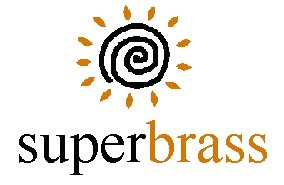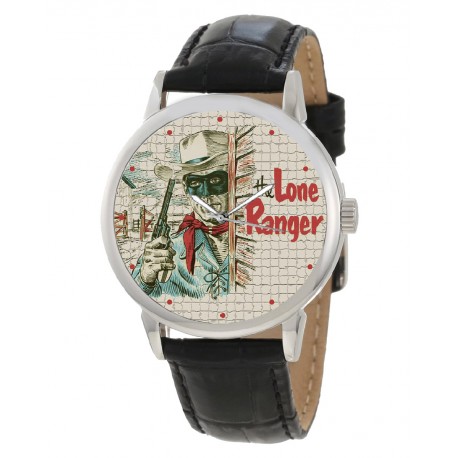No products
Pocket & Wrist Watches
- Pocket & Wrist Watches
- Music Instruments
- Brass Band & Woodwinds
- Ethnic Indian Instruments
- Guitars, Mandolins & Strings
- Violin, Viola & Cello Fittings
- World Percussion
- Nautical Brass
- Collectible Damascened Knives
Classic Lone Ranger Vintage Gunslinger Comic Art Collectible Wrist Watch
COM-LRSM1
New product
- impressive 40 mm solid brass casing with stainless steel back
- premium 2040 quartz movement.
- original parchment art acrylic dial
- waterproof bracelet with brass buckle
- 1 year warranty
More info
Six Texas Rangers are ambushed by a band of outlaws led by Bartholomew "Butch" Cavendish. Later, a Native American named Tonto stumbles on the scene and recognizes the lone survivor, Ranger Reid (whose first name was never given on the show), as the man who had saved his life some time in the past. He nurses Reid back to health. The two men dig six graves for Reid's comrades, so that Cavendish will think there were no survivors. Among them is Reid's brother, Captain Daniel Reid, who is the Captain of the Texas Rangers. Reid fashions a black Domino mask using material from his brother's vest to conceal his identity. Even after the Cavendish gang is brought to justice, Reid continues to fight evil under the guise of the Lone Ranger.
Characters
The Lone Ranger
In every incarnation of the character to date, the Lone Ranger conducts himself by a strict moral code put in place by Striker at the inception of the character. Actors Clayton Moore and Jay Silverheels both took their positions as role models to children very seriously and tried their best to live by this creed. It reads as follows:
I believe...
- that to have a friend, a man must be one.
- that all men are created equal and that everyone has within himself the power to make this a better world.
- that God put the firewood there, but that every man must gather and light it himself.
- in being prepared physically, mentally, and morally to fight when necessary for that which is right.
- that a man should make the most of what equipment he has.
- that 'this government of the people, by the people, and for the people' shall live always.
- that men should live by the rule of what is best for the greatest number.
- that sooner or later...somewhere...somehow...we must settle with the world and make payment for what we have taken.
- that all things change but truth, and that truth alone, lives on forever.
- in my Creator, my country, my fellow man.
In addition, Fran Striker and George W. Trendle drew up the following guidelines that embody who and what the Lone Ranger is
- The Lone Ranger is never seen without his mask or a disguise.
- With emphasis on logic, The Lone Ranger is never captured or held for any length of time by lawmen, avoiding his being unmasked.
- The Lone Ranger always uses perfect grammar and precise speech completely devoid of slang and colloquial phrases, at all times.
- When he has to use guns, The Lone Ranger never shoots to kill, but rather only to disarm his opponent as painlessly as possible.
- Logically, too, The Lone Ranger never wins against hopeless odds; i.e., he is never seen escaping from a barrage of bullets merely by riding into the horizon.
- Even though The Lone Ranger offers his aid to individuals or small groups, the ultimate objective of his story never fails to imply that their benefit is only a by-product of a greater achievement—the development of the west or our country. His adversaries are usually groups whose power is such that large areas are at stake.
- Adversaries are never other than American to avoid criticism from minority groups. There were exceptions to this rule. He sometimes battled foreign agents, though their nation of origin was generally not named. One exception was helping the Mexican Juarez against French troops of Emperor Maximilian, as occurred in radio episodes such as "Supplies for Juarez" (18 September 1939), "Hunted by Legionnaires" (20 September 1939) and "Lafitte's Reinforcements" (22 September 1939).
- Names of unsympathetic characters are carefully chosen, never consisting of two names if it can be avoided, to avoid even further vicarious association—more often than not, a single nickname is selected.
- The Lone Ranger never drinks or smokes, and saloon scenes are usually interpreted as cafes, with waiters and food instead of bartenders and liquor.
- Criminals are never shown in enviable positions of wealth or power, and they never appear as successful or glamorous.
Reid decides to use only silver bullets, to remind himself that life, too, is precious and, like his silver bullets, not to be wasted or thrown away.
The Lone Ranger's first name
Although the Lone Ranger's last name is given as Reid, his first name is not definitely specified. According to the story told in the radio series, the group of six ambushed Rangers was headed by Reid's brother, Captain Dan Reid. Some later radio reference books, beginning with Radio's Golden Age (Eastern Valley Press, 1966), claimed that the Lone Ranger's first name was John;[14] however, both the radio and television programs avoided mentioning his first name. His first name also was not mentioned in contemporaneous Lone Ranger newspaper comics, comic books, and tie-in premiums. Fran Striker's obituary (1962) and a Gold Key Comics (1964) retelling of the origin both stated that "Dan" was the Lone Ranger's first name, not his brother's. Purported middle names for Dan and John Reid are of unknown origin and were apparently invented by later writers.
It appears that the first use of the name "John Reid" in media was in a scene in the 1981 big-screen film The Legend of the Lone Ranger in which the surviving Reid digs an extra grave for himself. This appeared to give the use of the first name John a degree of official standing, although the name "Luke Hartman" was used in the 2003 TV-movie/unsold series pilot. The name "John Reid" also appears in a recent Lone Ranger comic book series. But Lone Ranger fans consider the name "John" non-canonical. It has been said in jest that The Lone Ranger's first name actually is "The."
The name of Captain Reid's son, the Lone Ranger's nephew, a later character first introduced in the radio series, who became a sort of juvenile sidekick to the Masked Man, is also Dan Reid. When Trendle and Striker later created The Green Hornet, they made this Dan Reid the father of Britt Reid, alias the Green Hornet, thereby making the Lone Ranger the Green Hornet's great-uncle.
Tonto
The character did not make his appearance until the eleventh episode of the radio show. Fran Striker told his son that Tonto was added so that the Lone Ranger would have someone to talk to.[13] The radio program identified him as a member of the Potawatomi tribe, though some books say he was probably supposed to be an Apache.
The character spoke in broken pidgin English.
Because Tonto means "stupid" or "dumb" in Spanish, the character is renamed "Toro" (Spanish for "bull") or "Ponto" in Spanish-speaking countries. In fact, "Tonto" was named by William Jewell, who also came up with the term "kemosabe" based on the name of a summer camp in upstate Michigan. In the local native American language, "Tonto" meant "wild one."
Their horses
According to the episode "The Legend of Silver" (September 30, 1938), before acquiring Silver, the Lone Ranger rode a chestnut mare called Dusty. After Dusty is killed by a criminal the Lone Ranger and Tonto are tracking, the Lone Ranger saves Silver's life from an enraged buffalo and, in gratitude, Silver chooses to give up his wild life to carry him.
The origin of Tonto's horse, Scout, is less clear. For a long time, Tonto rides a white horse called White Feller. In "Four Day Ride" (August 5, 1938), Tonto is given a paint horse by his friend Chief Thundercloud, who then takes White Feller. Tonto rides this horse and refers to him simply as "Paint Horse" for several episodes. The horse is finally named Scout in "Border Dope Smuggling" (September 2, 1938). In another episode, however, the Lone Ranger, in a surge of conscience, releases Silver back to the wild. The episode ends with Silver returning, bringing along a companion who becomes Tonto's horse, Scout.
Whenever the Lone Ranger mounts Silver, he shouts, "Hi-yo, Silver! Away!" Besides sounding dramatic, this shout originally served to tell the radio audience that a riding sequence was about to start.[citation needed] Bill Cosby complained in his book Cosbyology that, when the TV version came around, the Lone Ranger still used the line for reasons he could not figure out.[7] In an echo of the Lone Ranger's line, Tonto frequently says, "Git-um up, Scout!" (The phrase became so well embedded in the Lone Ranger mythos that International Harvester used it as an advertising line to promote their Scout utility vehicle in the 1970s.)
Reviews
No customer reviews for the moment.




